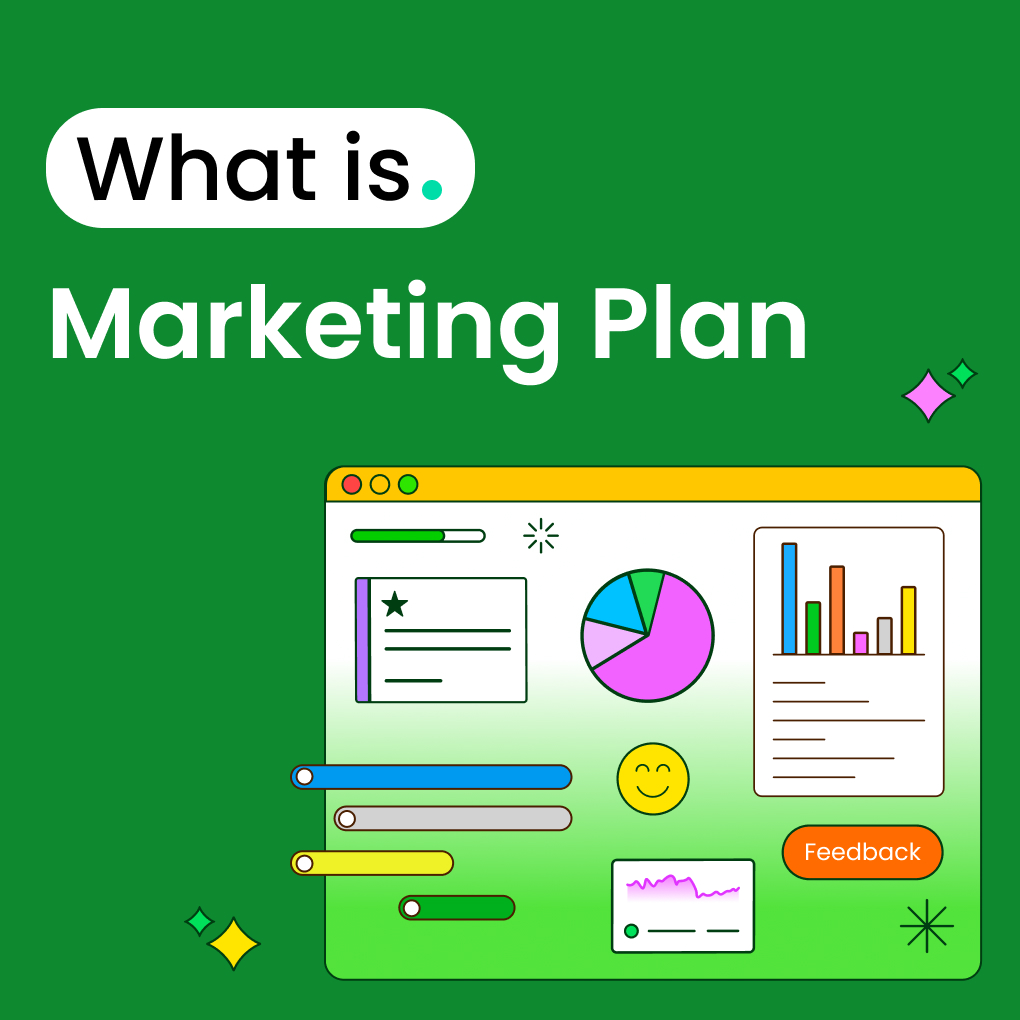A marketing plan serves as a roadmap that guides a business toward achieving its goals. It outlines the strategies and activities necessary for growth, along with specific objectives and targets. Effectively allocating resources to meet these marketing goals is the core of successful market planning.
The structure of a marketing plan includes research, objectives, and more. It identifies the target audience and outlines how to reach them. Without a clear plan, a company risks wasting time and money on ineffective campaigns.
A marketing plan goes beyond just advertising. It encompasses pricing, promotions, and customer relationships. A strong plan aligns with business goals while allowing for flexibility to adapt as needed.
What Is a Marketing Plan?
A marketing plan is a strategic roadmap that outlines how a business will reach its target market, including its goals, target customers, and methods to achieve them. It is essential for organizing efforts, tracking results, and adapting strategies. A well-structured marketing plan aligns with business goals, helps businesses understand their audience, and allows for flexibility in response to market changes, ultimately supporting steady growth.
Marketing Plan vs. Business Plan
A business plan outlines the entire company, covering finances, operations, and long-term goals. In contrast, a marketing plan focuses specifically on attracting and retaining customers. While a business plan provides a broad overview, a marketing plan details how promotions, pricing, and advertising will boost sales.
Both plans complement each other but serve different purposes. A business plan secures funding and directs overall growth, while a marketing plan ensures that the right customers learn about the business and choose its products.
Marketing Strategy vs. Marketing Plan
Marketing involves two main components: strategy and execution. A marketing strategy is the overarching idea—how a business will compete and win customers. It answers questions like “Who is our audience?” and “What sets us apart?”
The marketing plan translates that strategy into action. It outlines specific steps, such as social media campaigns, email marketing, or discounts. While the strategy sets the direction, the plan serves as a roadmap.
Understanding the marketing strategy helps businesses stay focused. A strategy without a plan is merely an idea, and a plan without a strategy lacks direction. Together, they ensure that marketing efforts are effective and aligned with business goals.
What does a marketing plan accomplish? It organizes efforts, conserves resources, and increases the likelihood of success. Whether launching a new product or entering a new market, a solid plan makes the process smoother and more predictable.
Purpose of a Marketing Plan
A marketing plan serves as a roadmap for businesses to effectively reach their target customers. It clarifies the company’s goals and explains how marketing efforts will support them. Recognizing the purpose of a marketing plan helps businesses stay focused, avoid wasted efforts, and accurately measure success.
Strategic Alignment
One key purpose of a marketing plan is to ensure that all activities align with business objectives. Without this alignment, marketing efforts may not contribute to growth. The plan connects daily promotions, advertising, and customer outreach to broader company goals.
What does the marketing plan include regarding strategic alignment? It defines how marketing supports sales targets, brand awareness, or market expansion. The first section of a marketing plan often clearly outlines these connections, keeping teams focused on the same priorities and preventing disjointed campaigns.
Goal Setting and Measurement
A strong marketing plan establishes clear, measurable goals. These could include increasing website traffic, generating leads, or boosting sales within a specific timeframe. Without defined targets, businesses cannot track progress or demonstrate marketing’s impact.
What should a marketing plan include for effective measurement? Key performance indicators (KPIs) help assess success. These might include conversion rates, social media engagement, or customer acquisition costs. Regular tracking allows for quick adjustments if certain strategies do not perform well.
Team and Stakeholder Communication
A marketing plan enhances communication across teams and with stakeholders. It clarifies who is responsible for which tasks, what resources are needed, and how results will be reported. This transparency prevents confusion and ensures everyone understands their role.
For leadership teams, the plan illustrates how marketing contributes to business success. Investors and partners gain confidence from seeing a structured approach. Employees work more efficiently when expectations and processes are clear.
A well-constructed marketing plan does more than guide promotions. It aligns efforts with business needs, sets measurable targets, and coordinates teams. These elements work together to maximize marketing’s impact and drive growth.
What Should a Marketing Plan Include?
A well-crafted marketing plan includes essential elements that guide your business effectively. When preparing a marketing plan, it is important to carefully consider your customers, competition, and measures of success. The structure of the marketing plan should be clear and useful, allowing teams to easily understand and implement it. When you grasp the purpose of a marketing plan, you can create a document that drives results instead of gathering dust on a shelf.
Executive Summary
The executive summary provides an overview of the entire marketing plan. It highlights the main objectives, target audience, and key strategies in one or two pages. Although this section is written last, it appears first in the document. Leaders and investors often review this part to quickly understand the plan’s direction without reading the entire document. A strong summary clearly defines what the business aims to achieve and how marketing will help accomplish this.
Market Research & Target Audience
Understanding your customers is the first step in effective market planning.
This section outlines the target audience’s demographics, interests, and buying habits. It explains how these customers spend their time, the challenges they face, and how your offerings can address those challenges. Research can be conducted through surveys, interviews, and customer data. The more accurate the information, the better your marketing strategies will perform. Without insights into your audience, your campaigns may not resonate.
Competitive Analysis
Every business operates in a competitive landscape. The competitive analysis section of the marketing plan reviews the main competitors, what they do well, and why they succeed. It also examines their weaknesses and areas where they fall short. This analysis includes their pricing, promotions, customer service, and market positioning.
The goal is to identify gaps in the market that your business can fill or unique qualities you can emphasize. Understanding your competition helps you craft messages that distinguish you from others and attract new customers. As competitors adjust their strategies, it is essential to regularly update your analysis.
Marketing Objectives and KPIs
A clearly defined set of goals illustrates what the marketing plan aims to achieve. Goals should be specific. For instance, you might aim to increase website traffic by 20% or generate 500 new leads each quarter. Key performance indicators (KPIs) are metrics that track progress toward these goals.
Common KPIs include conversion rates, social media engagement, and sales figures. Setting measurable targets allows you to assess what is working and what is not. Objectives should challenge the team while remaining realistic.
Marketing Strategies and Tactics
This section translates broad goals into actionable steps. Strategies refer to overarching approaches, such as using content marketing to build brand awareness. Tactics detail the specific actions you will take, such as posting weekly blogs and running Facebook ads.
The plan should clarify which channels will be used, what content will be created, and how often activities will occur. The tactics must align with the audience’s preferences and the company’s budget. Using different methods for various customer segments often yields the best results.
Budget and Timeline
Every marketing effort requires resources. A budget outlines projected expenses for advertising, content creation, events, and more. It helps you avoid overspending and ensures funds are allocated to effective strategies. The timeline sets deadlines for each activity to keep the team on track.
Some campaigns may run year-round, while others may be seasonal. Preparing for busier times helps the team coordinate effectively. It is wise to allow some flexibility in budgets and timelines for unexpected opportunities.
Metrics and Performance Tracking
The final key component is a system for measuring results. This section outlines the process for collecting and reviewing data to evaluate the plan’s success. Tools like Google Analytics, CRM systems, or social media insights can provide valuable information. Consistent reporting allows for early detection of trends, enabling the business to respond quickly and adjust marketing strategies as needed.
If you do not monitor progress, you may not know whether your efforts are effective or if resources are being wasted. Data on marketing effectiveness demonstrates the value of marketing to company leaders and justifies future budgets.
A solid marketing plan addresses all these areas sufficiently to guide daily operations while remaining adaptable to change. Plans that can adjust to the complexities of growth are ideal for business development. They help the team stay focused on their goals without losing sight of the bigger picture. When structured properly, a marketing plan can be a powerful tool for growth.
How to Create a Marketing Plan (Step-by-Step)
Building an effective marketing plan requires careful thought and organization. The marketing planning process involves several key steps to create a comprehensive strategy. A good plan starts with clear goals and ends with a system for tracking results. A structured approach helps businesses avoid common mistakes and develop effective marketing. Breaking down the marketing strategy into actionable steps makes it easier for any team to follow.
Step 1 – Define Your Mission and Objectives
A marketing plan is meaningless without clear direction. Begin by writing down the business’s overall mission and how marketing supports it. Objectives should be specific, such as increasing brand awareness or generating more leads. These goals guide all other decisions in the plan.
Good objectives follow the SMART criteria—they are Specific, Measurable, Achievable, Relevant, and Time-bound. For example, “Grow email subscribers by 25% in six months” is more effective than simply stating, “Get more subscribers.” This first step lays the foundation for everything that follows.
Step 2 – Identify Your Target Market
Market planning fails without a clear understanding of who to target. This step involves researching and defining your ideal customer. Consider demographics like age, location, and income, as well as psychographics—interests, challenges, and buying habits. The more specific this information is, the better your marketing will perform.
Many businesses mistakenly try to target everyone, which often results in reaching no one effectively. Creating detailed buyer personas helps the team visualize and understand the people they aim to reach.
Step 3 – Conduct SWOT or Situational Analysis
A SWOT analysis examines the business’s Strengths, Weaknesses, Opportunities, and Threats. This honest assessment of the current situation helps shape effective strategies. Strengths might include a strong brand or unique product features, while weaknesses could be a limited budget or a small team.
Opportunities may arise from new market trends, while threats could include strong competitors. This analysis helps businesses leverage their advantages while preparing for challenges. It is a crucial part of the marketing plan structure that many companies rush through or overlook.
Step 4 – Outline Your Marketing Strategies
With goals set and analysis complete, it is time to decide how to reach customers. The marketing strategy outline should detail which channels to use and what messages to convey. This might include social media, email campaigns, content marketing, or traditional advertising.
The strategies should align with the target audience’s preferences and the company’s strengths. For example, a visually appealing product might focus on Instagram, while a B2B service might utilize LinkedIn. Each strategy should directly support the objectives established in Step 1.
Step 5 – Set Budget and Timeline
Even great ideas require practical planning. This step determines how much money to allocate and when to execute each part of the plan. The budget should distribute funds to different strategies based on their expected impact. Some activities, like social media, may be low-cost, while others, like paid ads, may require a larger investment.
The timeline sets specific dates for launching campaigns and achieving milestones. A content calendar helps plan blog posts, emails, and social media updates. Realistic budgeting and scheduling prevent last-minute scrambles and wasted resources.
Step 6 – Assign Responsibilities
A marketing plan is ineffective if no one knows their roles. This step ensures that every task has an owner. Larger teams may divide work by specialty—one person handles social media, while another writes content. Smaller businesses may have team members take on multiple roles.
Regardless of team size, clear responsibilities prevent confusion and missed deadlines. Regular check-ins help keep everyone on track. It is also important to identify who needs to approve different parts of the plan before they go live. Well-defined assignments make execution much smoother.
Step 7 – Monitor and Optimize
The final step transforms the marketing planning process into an ongoing cycle. Set up systems to track the performance of each strategy. Monitor website traffic, conversion rates, social media engagement, and sales figures.
Regular reports help identify what is working and what needs adjustment. No plan should be set in stone; the best marketers continuously test and refine their approaches. This step ensures the business achieves better results over time by learning from real data rather than relying on assumptions.
Marketing Planning Process
An effective marketing plan consists of clear phases that guide businesses from strategy to results. The plan should logically progress through the stages of planning, action, and review. This approach helps teams stay organized while allowing them to adapt as needed. A key objective of a marketing plan is to create a system that transforms ideas into measurable outcomes.
Planning Phases: Strategy → Execution → Measurement
The marketing planning process involves three main phases. First, the strategy phase establishes goals and identifies the best approach. During this phase, businesses research their market, analyze competitors, and choose the tactics they will use. Next is the execution phase, where teams carry out planned activities such as social media campaigns or email marketing.
Finally, the measurement phase tracks performance to determine what worked and what needs improvement. These phases create a continuous cycle that enhances the effectiveness of marketing efforts.
Tools for Marketing Plan Development

Unlike generic project management tools, Morningmate is specifically designed for marketing teams. Its user-friendly interface combines planning, collaboration, and reporting in one platform. The platform offers real-time updates and notifications to keep distributed teams aligned, while its integration capabilities connect with other marketing tools for smooth workflows.
For businesses aiming to streamline their marketing operations, Morningmate reduces planning overhead and enhances execution quality. By centralizing the entire marketing planning process, teams can move more quickly from strategy to results while maintaining visibility at every step. The platform’s flexibility makes it valuable for both startups creating their first marketing plan and large enterprises managing complex, multi-channel campaigns.
With Morningmate, what usually takes weeks of back-and-forth emails and document exchanges can be completed in days through structured collaboration. The outcome is more actionable, measurable, and ultimately more effective marketing plans that drive business growth.
Final Thoughts on Marketing Plans
A marketing plan is a dynamic document that should evolve with your business, serving as a flexible roadmap rather than a strict guideline. Regular updates are crucial as markets change rapidly; what worked previously may not be effective now. Monthly reviews help teams identify trends and adjust strategies, ensuring the plan remains relevant and efficient. As a business grows, its marketing needs will also change, requiring adjustments in focus, goals, and budgets. Aligning the marketing plan with business objectives ensures that every investment contributes to long-term success, providing clear direction throughout the company’s development.



